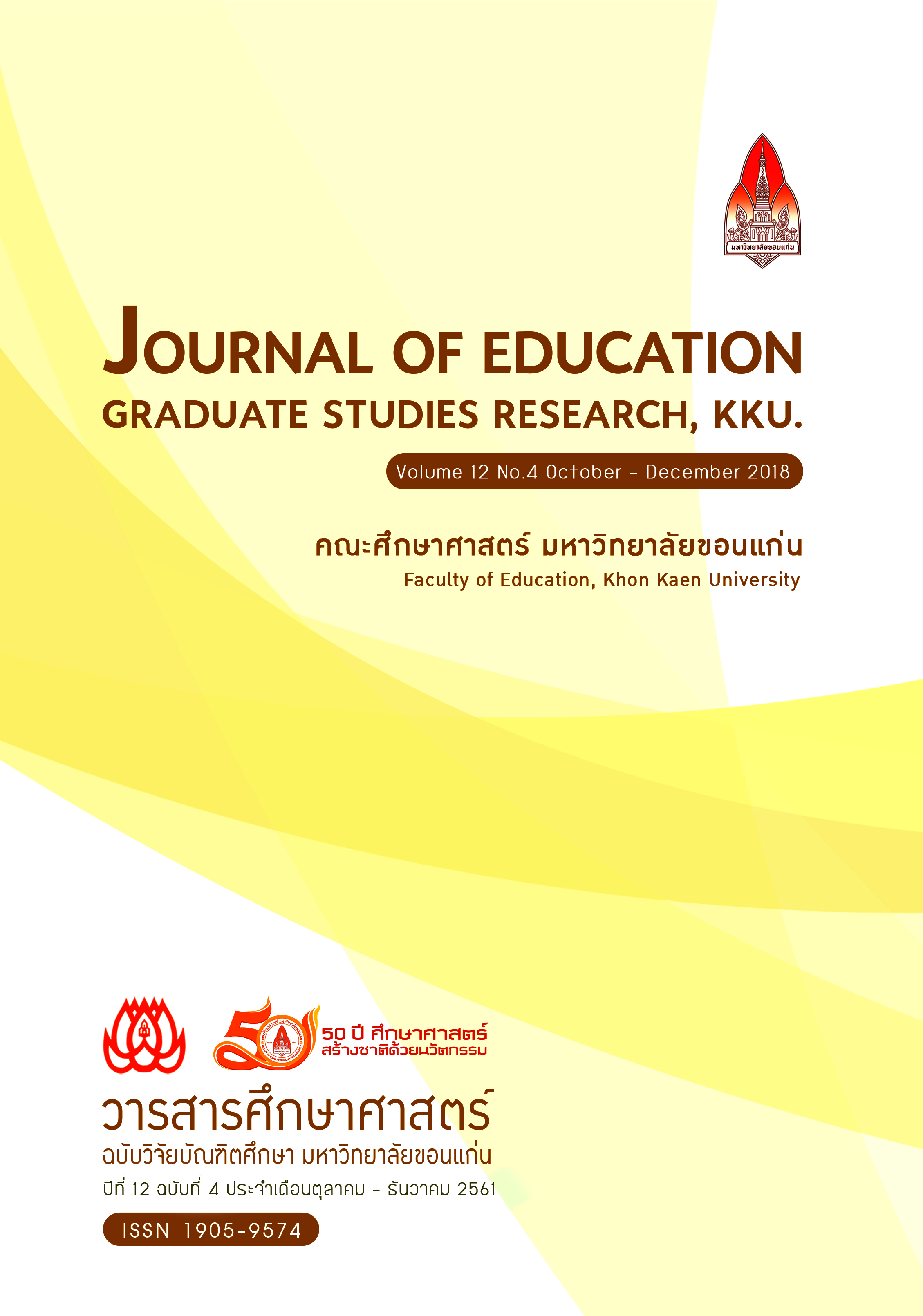The Development of Mathematics Problem Solving Ability on The Normal Curve for Grade 12 Students Using STEM Education with KWDL Technique
Main Article Content
Abstract
The objectives of this study included: 1) to develop grade 12 students’ mathematics problem-solving ability on a normal curve using the STEM Education together with KWDL Technique in order that the students made a mean score of 70% of the full marks and 70% of the group passed the prescribed criterion and 2) to study the student’s satisfaction with the learning activities based on the STEM Education and KWDL Technique. The target group consisted of 40 grade 12 students from Classroom 6/6 at Sichompoo Sueksa School, under the Office of Khon Kaen Provincial Administration Organization. During the first semester of the 2016 academic year. Three categories of instruments used in the study included: 1) research tool consisting of 11 lesson plans basing on the STEM Education and KWDL Technique and took 12 instructional hours to complete, 2) reflection tool consisting of a teacher’s teaching behavior observation form, a student opinions recording form, a learning outcome recording form and end-of-spiral quizzes, and 3) evaluation tool consisting of a 5-item essay test on the students’ mathematics problem-solving ability and a 22-item questionnaire with a 5-level scale to elicit the students’ opinions regarding the learning activities basing on the STEM Education and KWDL Technique. The collected data were analyzed for the arithmetic mean, standard deviation and percentage, and qualitative data were analyzed by means of content analysis.
The findings show that: 1) The students made a mean score of 37.83 or 75.65% of the full marks on mathematics problem-solving ability, and 32 students or 80.00% of the group passed the prescribed criterion of 70% which is higher than the prescribed criterion; 2) The students as a whole expressed a “highest” level of satisfaction with the learning activities basing on the STEM Education and KWDL Technique.
Article Details
References
จิราภรณ์ อุปภา. (2554). การจัดการเรียนรู้โดยใช้เทคนิค KWDL ในการแก้โจทย์ปัญหาคณิตศาสตร์ เรื่อง อัตราส่วนและร้อยละของนักเรียนระดับประกาศนียบัตรวิชาชีพชั้นปีที่ 1. วิทยานิพนธ์ปริญญาครุศาสตร มหาบัณฑิต สาขาวิชาคณิตศาสตรศึกษา บัณฑิตวิทยาลัย มหาวิทยาลัยราชภัฏมหาสารคาม.
สถาบันทดสอบทางการศึกษาแห่งชาติ (องค์กรมหาชน). (2558). ผลการทดสอบวิชาคณิตศาสตร์ชั้นมัธยมศึกษาปีที่ 6 ค้นเมื่อ 18 ตุลาคม 2559, จาก http://www.niets.or.th
สถาบันส่งเสริมการสอนวิทยาศาสตร์และเทคโนโลยีกระทรวงศึกษาธิการ. (2553). คู่มือครูรายวิชาพื้นฐาน คณิตศาสตร์ ชั้นมัธยมศึกษาปีที่ 6 กลุ่มสาระการเรียนรู้คณิตศาสตร์ ตามหลักสูตรแกนกลาง การศึกษาขั้นพื้นฐานพุทธศักราช 2551. กรุงเทพฯ: สกสค. ลาดพร้าว.
พลศักดิ์ แสงพรมศรี. (2557). การเปรียบเทียบผลสัมฤทธิ์ทางการเรียน ทักษะกระบวนการทางวิทยาศาสตร์ขั้นสูง และเจตคติต่อการเรียนเคมี ของนักเรียนชั้นมัธยมศึกษาปีที่ 5 ที่ได้รับการจัดการเรียนรู้สะเต็มศึกษากับแบบปกติ. ปริญญานิพนธ์วิทยาศาสตรมหาบัณฑิต สาขาวิชาเคมี คณะวิทยาศาสตร์ มหาวิทยาลัยมหาสารคาม.
สุกัลยา จวนสาง. (2555). ผลการจัดการเรียนรู้แบบร่วมมือกันเรียนรู้เทคนิคกลุ่มช่วยเหลือเพื่อนรายบุคคลร่วมกับเทคนิค KWDL. วิทยานิพนธ์ปริญญาครุศาสตรมหาบัณฑิต สาขาวิชาหลักสูตรและการสอน บัณฑิตวิทยาลัย มหาวิทยาลัยราชภัฏเชียงราย.
สุภาพ โสรส. (2555). การเปรียบเทียบการคิดอย่างมีวิจารณญาณ และผลสัมฤทธิ์ทางการเรียนชั้นมัธยมศึกษาปีที่ 3 ที่ได้รับการจัดการเรียนรู้ด้วยเทคนิค KWDL และเทคนิค SSCS ตามทฤษฎีการสร้างความรู้ด้วยตนเอง. วิทยานิพนธ์ปริญญาการศึกษามหาบัณฑิต สาขาวิชาการวิจัยศึกษา บัณฑิตวิทยาลัย มหาวิทยาลัยมหาสารคาม.
อัมพร ม้าคนอง. (2553). ทักษะและกระบวนการทางคณิตศาสตร์: การพัฒนาเพื่อพัฒนาการ. กรุงเทพฯ: จุฬาลงกรณ์มหาวิทยาลัย.
Carr, E. & Ogle, D. (1987). KWL Plus: A Strategies for Comprehension and Summarization. Journal of Reading. 30(7), 626-663. Retrieved October 18, 2015, from http://www.stemeducationjournal.com/authos/instructions.
Clark, D., Sengupta, P., Brady, C., Martinez-Garza, M., & Killingsworth, S. et al. (2014).
Disciplinary integration of digital games for science learning. International Journal of STEM Education. Retrieved October 18, 2015, from http://www.stemeducationjournal.com/authos/instructions.
Kemmis, S. & McTaggart, R. (1992). The action research planner. Geelong, Victoria: Deakin University Press.
Krulik, S., & Rudnick J. (1988 ). Problem Solving. Massachusetts: Allyn and Bacon.Polya, G. (1985). How to solve it. Princeton, NJ: Princeton University Press.s
Shaw, G. M., Chambless, M. S., Chessin, D, R., Price, V., & Beardain, G. (1997). Cooperative problem solving: Using K-W-D-L as an organizational technique. Journal of Reading, 3(9), 482-486. Retrieved October 18, 2015, from http://www.stemeducationjournal.com/authos/instructions
Star, J., Chen, J., Taylor, M., Durkin, K., Dede, C., & Chao, T. et al. (2014 ). Studying technology-based strategies for enhancing motivation in mathematics. International Journal of STEM Education. Retrieved October 18, 2015, from http://www.stemeducationjournal.com/ authors/instructions
Vasquez, J.A., Sneider, C., and Comer, M. (2013). STEM Lesson Essentials: Integrating Science, Technology, Engineering, and Mathematics. Portsmouth, NH: Heinemann.

